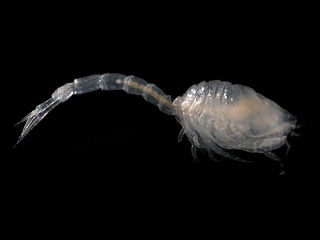
Cumacea is an order of small marine crustaceans of the superorder Peracarida, occasionally called hooded shrimp or comma shrimp. Their unique appearance and uniform body plan makes them easy to distinguish from other crustaceans. They live in soft-bottoms such as mud and sand, mostly in the marine environment. There are more than 1,500 species of cumaceans formally described. The species diversity of Cumacea increases with depth.

Diastylis is a genus of crustaceans which belong to the family Diastylidae. It includes the following species:

Diastylidae is one of the eight most commonly recognised families of crustaceans of the order Cumacea. They are marine creatures especially common around the 30th parallel north.

Bodotriidae is a family of crustaceans belonging to the order Cumacea. Bodotriids have a worldwide distribution in shallow and deep waters. There are over 380 described species in over 30 genera, being the most diverse cumacean family. Their external morphology differs from other cumaceans by a combination of traits that independently are not unique to the family: the telson is fused to the last abdominal segment, the dorsal part of the mandible has a boat shape (naviculoid), exopods exist on the third maxilliped and the first peraeopod, and there is a uropodal endopod with one or two articles.

Pseudocumatidae is a family of crustaceans of the order Cumacea. Its members have a small, free telson. The uropods bear endopods on one segment. The males have two pairs of rather rudimentary pleopods and the flagella of the second antenna reach far beyond the pereon. In females the second antenna is much smaller than the first antenna.
Ceratocumatidae is a family of crustaceans of the order Cumacea. Ceratocumatidae have a small free telson. The endopods of the uropods are present on only one segment. Males have 5, 4 or 3 pairs of pleopods. All maxillipeds and some of the pereiopods bear exopods. The gill apparatus has no supporting gill plates.
Gynodiastylidae is one of the eight most commonly recognised families of crustaceans of the order Cumacea. They are especially prevalent in the southern hemisphere, with some types described from Japan, Thailand and the Persian Gulf. Most are found at less than 100 metres (330 ft) depth.
Lampropidae is a family of cold-water crustaceans belonging to the order Cumacea. Members of Lampropidae are relatively easily recognised because they all at have at least three terminal setae on the telson. The telson is medium to large and not fused with the last segment of the pleon. The endopods of the uropods are present on all three members. In the males the flagellum of the second antenna reaches beyond the carapace; moreover, they possess pleopods. In the females the second antenna is somewhat shorter than the first. There are exopods on the third maxilliped and strongly reduced or absent on the third pereopods.

Leuconidae is a family of marine hooded shrimp. The family was established by Georg Ossian Sars in his 1878 study of Mediterranean cumaceans.

Nannastacidae is a family of crustaceans belonging to the order Cumacea. They have no free telson. The endopods of the uropods are present on one segment. There are exopods on the maxillipeds and generally one on pereopods 1–4 in males and 1–2 in females. In the females the second antenna is much shorter than the first. It contains the following genera:

Bodotria is a genus of crustaceans which belong to the family Bodotriidae. It includes the following species:

Iphinoe is a genus of crustaceans which belong to the family Bodotriidae. It includes the following species:
Nannastacus is a genus of crustaceans in the order Cumacea. It contains the following species:

Diastylis laevis is a species of crustacean belonging to the order Cumacea and the genus Diastylis. It occurs from Skagerrak to the Côte d'Ivoire, but not in the Mediterranean Sea. It grows up to 11 millimetres (0.43 in) long.
Chalarostylis is a genus of cumacean crustaceans in the Lampropidae family, containing two species, including the one formerly placed in Dasylamprops, which is now considered a synonym of Chalarostylis.
Cyclaspis elegans is a species of small marine crustacean (cumacean) in the genus Cyclaspis that lives in Lyttelton Harbour, New Zealand.

Pseudocuma longicorne is a marine species of cumacean in the family Pseudocumatidae.

Trinchesia caerulea is a species of sea slug, an aeolid nudibranch, a marine gastropod mollusc in the family Trinchesiidae.
Dimorphostylis echinata is a species of crustacean from the Diastylidae family. The scientific name of this species was first published in 1962 by Gamo.








